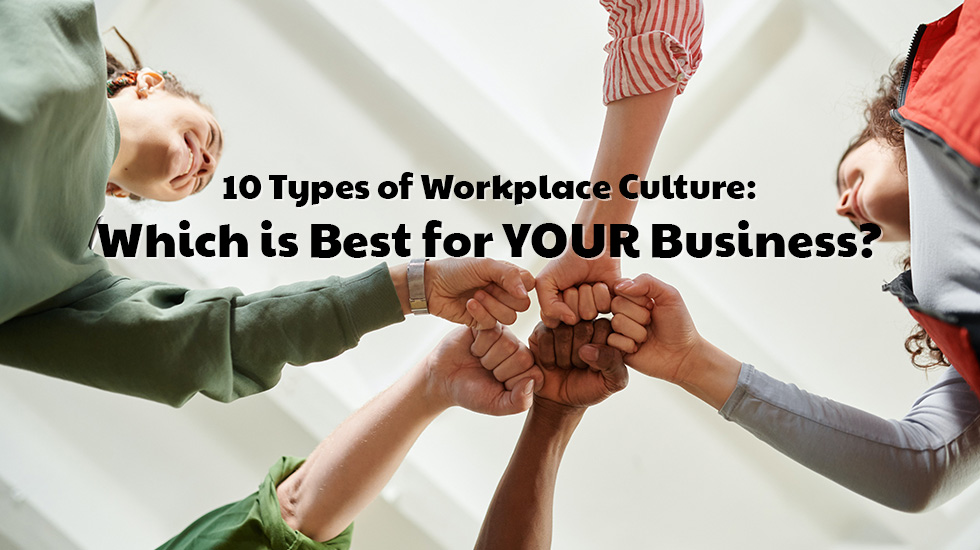Resources > Blog > 10 Types of Workplace Culture: Which is Best for YOUR Business?
Company culture stems from management, then rolls on down through the ranks. As such, much of a company's culture takes care of itself. If you make smart managerial decisions and hire the people you think will best represent your business, you'll have the healthy, productive company culture you want.
All that said, it's never a bad idea to educate yourself on the types of workplace culture that exist. While no actual workplace culture fits neatly into one box, understanding the ways other successful companies operate will help you do the same.
We've done the research and put together a comprehensive list of workplace cultures evident in companies across the country. Regardless of your size or your industry, you'll be able to cherry-pick core values from any of the culture types in this list and integrate them into your existing managerial strategy.
Are you ready? Let's hop right in!
Workplace Culture #1: Strong Leadership
This workplace culture revolves around leadership-both existing and rising. Mentorship programs, coaching programs, and leadership training are implemented and stressed. Existing leaders put their subordinates in positions to succeed, and the best performing employees are put on the fast track for leadership positions of their own.
You might think having a strong corporate structure is necessary when it comes to fostering a culture of strong leadership. This isn't necessarily true. A coffee shop where all incoming baristas are trained to be competent shift leaders can have a great culture of leadership.
Workplace Culture #2: Customer Service Excellence
Here's a workplace culture that is emphasized in a number of industries-from the service industry to software sales. The "customer is always right" attitude reigns supreme in a culture of customer service excellence. Even employees who aren't customer-facing go about their days with customer satisfaction in mind.
Products are manufactured with ease of use in mind, customer surveys are conducted regularly, and there is a ton of importance placed on customer ratings and reviews. Social media accounts are monitored constantly for customer service related issues, and the phones are always open. Amazon, whose customer satisfaction is universally praised, is an example of a company with a culture of customer service excellence.
Workplace Culture #3: Sales
Common earmarks of a sales culture include working product knowledge across all members of a staff, a commitment to consistently hitting quarterly sales goals and quotas, and a general focus on daily activities that will directly generate revenue for the company. Blending a sales culture and a customer-centered culture can lead to long-term success.
Companies like Oracle and Salesforce offer high commissions to incentivize sales and reinforce their sales-first cultures.
Workplace Culture #4: Role-Playing
In a role-playing culture, specialists are valued above all else: nothing is more important than mastery of your craft. Employees are trusted to take accountability over the projects for which they are qualified.
The hiring process is highly selective in a role-based workplace culture. Hires are made based more on skills than intangibles. Wages are typically high because employees have undergone extensive training for the position prior to getting hired. They have skills that not everybody possesses, and that few, if anyone, could fake. You'll find a strong role culture among craftsmen (as subcontractors working on a large project) and on web and software development teams, where individuals have the ability to write a specific computer programming language.
Workplace Culture #5: Innovation
A culture of innovation is a culture in which conventional ideas fall by the wayside. It's a common staple of companies that consistently attempt to stay on the cutting edge of industry trends and developments. Strict lines of communication and structural hierarchies are often subverted for the sake of airing out ideas that break new ground. The impression is one of a giant think tank-where company space is a breeding ground for ideas.
A company like Tesla is famously innovative, but smaller examples also come to mind-a student-run sports broadcast team, for instance, that finds new and exciting ways to deliver play-by-play to fans via social media.
Workplace Culture #6: Empowerment
Here's a culture in which no employee feels undervalued.
Regardless of position or rank, employees are meant to feel as if their role in the business is vital for operation. Wages are often generous, and low-ranking employees feel comfortable approaching their superiors with questions and suggestions. During a conflict, steps are taken to make employees feel as if they stand on equal footing with one another. Requests for bonuses, wage increases, and position changes are seriously considered and granted when appropriate.
Ben and Jerry's continuously empowers its employees through well-paying jobs, community service, and, of course, the opportunity to name new flavors of ice cream.
Workplace Culture #7: Power-Driven
A power-driven workplace culture is about one thing: survival of the fittest. Workplace competition is alive and well, and individuals put strategies in place to acquire power where it's available. This is typically seen in companies that also exhibit dominant sales cultures.
In a power-driven workplace culture, the "good of the whole" is often put aside in a power culture, and common goals are more often incidental than intended. They're especially common in investment banks, insurance sales, and financial consultancy firms.
Workplace Culture #8: Task-Oriented
A common trademark of a task-oriented culture is the use of small, collaborative teams to tackle inbound issues. Employees must have the ability to work well with one another and are interviewed by most or all members of their team to make sure they'll be a good fit if hired. Much of the day to day operation consists in getting in conference rooms and other collaborative spaces and hammering out team-specific strategies.
A marketing team game planning for a product launch might demonstrate a strong task-oriented culture as they coordinate responsibilities and attempt to meet goals over the course of a few weeks.
Workplace Culture #9: All-Stars
The biggest earmark of a culture of all-stars is a hiring process that is highly selective. The staff as a whole is comparatively small and highly creative, and there are few if any roles in the company that aren't 100% necessary. Think of this like role-player culture on steroids.
Expectations for innovation and personal success are high and are typically met or exceeded. The "one for all, all for one" mentality is not totally foregone, but competition can be intense. Many successful hedge funds and startups employee a roster of all-star employees.
Workplace Culture #10: Mission-Driven
You'll often see mission-driven workplace cultures within nonprofits and grassroots startups. Employees are hired based on their passion for a particular cause or line of work and are relied upon to maintain that passion throughout the course of their employment. Personal satisfaction and work-life balance can, at times, take a back seat to mission devotion.
Companies are active within their communities and have close working relationships with investors, partners, and clients alike. Genentech, a biotechnology company out of San Francisco that seek solutions for the world's most difficult-to-treat conditions, has a strong mission culture.
***
When deciding on the best workplace culture for your business, you don't need to choose just one. Pull characteristics from some of the examples of workplace cultures we talked about today and implement them. There's no better way to help your business and your employees succeed than developing a well-defined workplace culture.

















